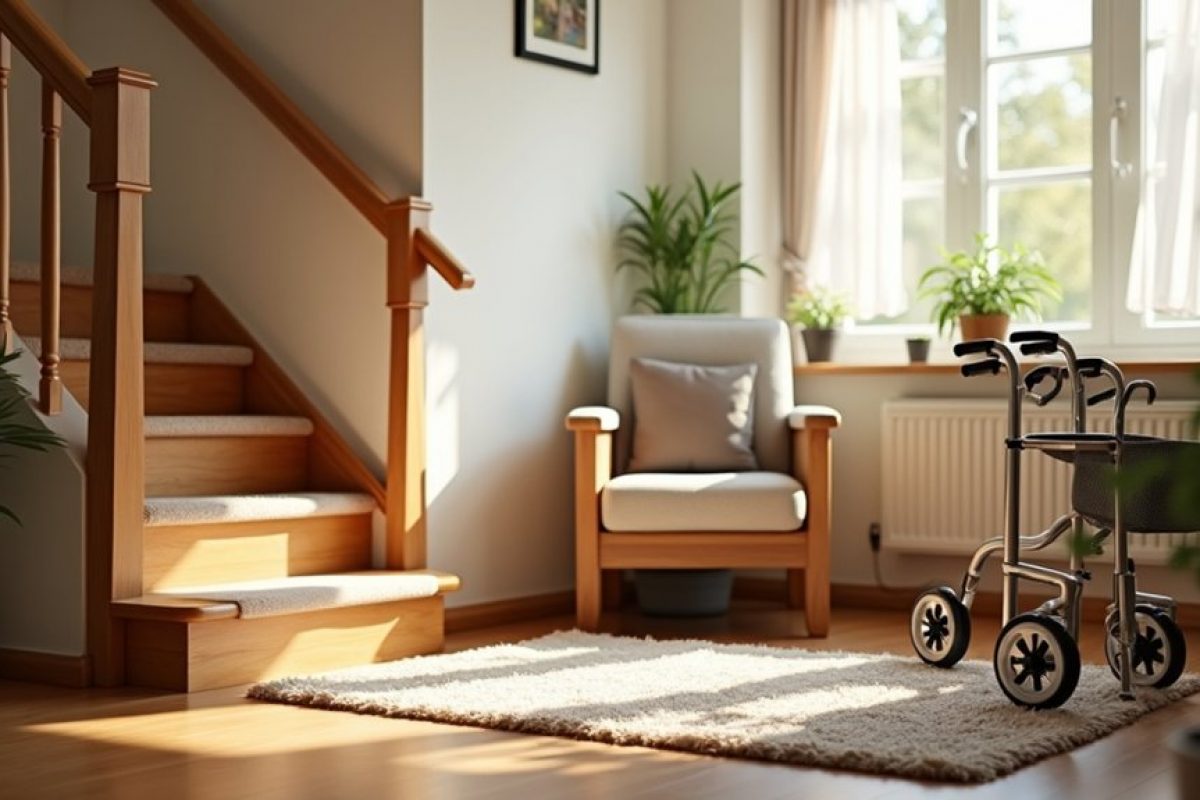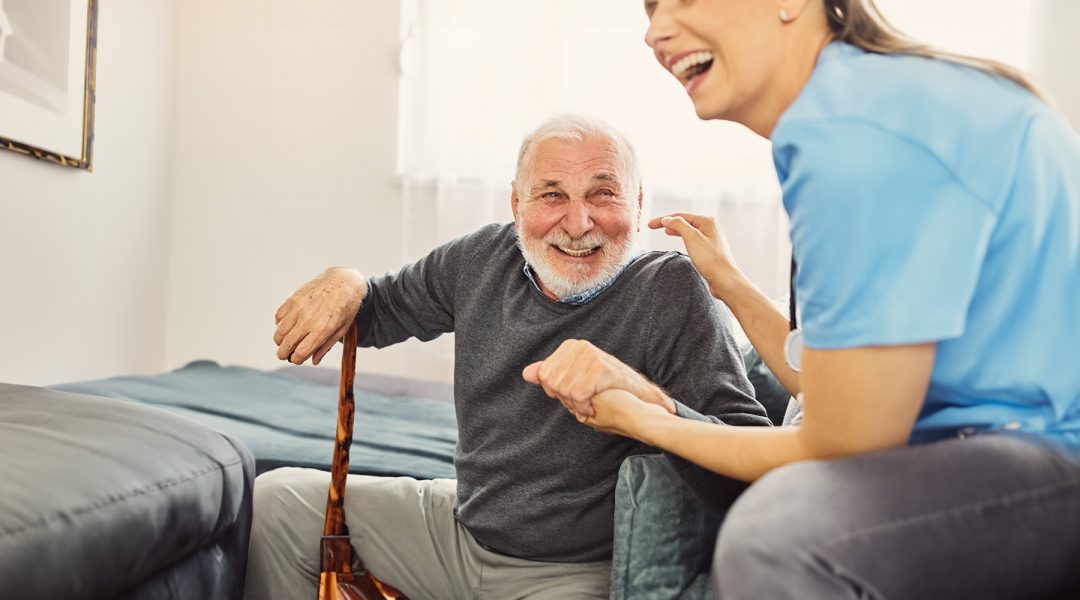To reduce fall risks for seniors, start by evaluating your home for hazards like loose rugs and clutter. Improve lighting, especially in hallways and staircases, to guarantee visibility. Use non-slip mats in high-risk areas and install grab bars in bathrooms. Organize living spaces to create clear pathways and choose appropriate footwear. Engaging in balance exercises can also enhance stability. There’s more to explore on how to make your home safe and supportive for seniors.
Key Takeaways
- Evaluate each room for hazards like loose rugs and clutter to minimize fall risks.
- Improve lighting in hallways and staircases to enhance visibility and safety.
- Install grab bars in bathrooms and handrails on staircases for added support.
- Use non-slip mats in kitchens and bathrooms to prevent slips and falls.
- Organize living spaces by removing clutter and arranging furniture for easy movement.
Assessing Your Home for Fall Hazards
When it comes to keeping your home safe, evaluating for fall hazards is essential. Start by walking through each room, looking for potential dangers like loose rugs, clutter, or uneven flooring.
Make sure your hallways and staircases are clear, as these areas often pose significant risks. Consider adding grab bars in bathrooms and non-slip mats in the kitchen.
If you provide respite care, ensuring a safe environment for your loved ones is even more critical. Encourage family and friends to help with this assessment, as fresh eyes can spot what you might miss. Additionally, addressing environmental hazards in your home can significantly reduce the likelihood of falls.
Improving Lighting Throughout the Home
Since proper lighting can greatly reduce the risk of falls, it’s essential to evaluate and improve the lighting throughout your home.
Start by ensuring all areas are well-lit, especially staircases, hallways, and entryways. Use bright, energy-efficient bulbs to enhance visibility.
Ensure all areas are well-lit, particularly staircases and hallways, using bright, energy-efficient bulbs for better visibility.
Consider adding night lights in bedrooms and bathrooms to guide seniors during nighttime trips. You might also want to install dimmer switches, allowing for adjustable lighting based on the time of day or activity.
Make sure windows are clean and unobstructed to maximize natural light. If you can, remove heavy curtains or replace them with lighter options. Additionally, addressing environmental hazards like poor lighting can significantly improve safety and reduce fall risks for seniors.
Using Non-Slip Mats and Rugs
Adequate lighting can only go so far in preventing slips and falls; the surfaces you walk on also play a significant role.
To enhance safety in your home, consider using non-slip mats and rugs. These can provide a stable footing, especially in areas like the kitchen and bathroom, where spills are common.
When choosing mats, verify they’ve a rubber backing to prevent sliding. It’s also wise to secure area rugs with double-sided tape to keep them in place.
Encourage family and friends to adopt these practices, helping to create a safer environment for everyone. Additionally, implementing respite care services can provide necessary support for caregivers, allowing them to focus on creating a safe home.
Installing Handrails and Grab Bars
To guarantee stability and support in your home, installing handrails and grab bars is essential, particularly in areas like staircases, bathrooms, and hallways.
These features provide the necessary grip and balance seniors need while moving about. When you install handrails on both sides of staircases, you help prevent slips and falls, making a significant difference in safety.
In bathrooms, grab bars near the toilet and in the shower offer added security during vulnerable moments. Make sure to choose sturdy options that can support weight and are securely fastened. Additionally, personal care support can help prevent falls and enhance overall safety for seniors in their homes.
Organizing Living Spaces for Ease of Movement
Creating a clutter-free environment is vital for seniors to navigate their homes safely and confidently. Start by removing unnecessary items from floors, hallways, and common areas.
Keep furniture arranged to allow clear pathways, guaranteeing there’s enough space for easy movement, especially for walkers or mobility aids. Use storage solutions like baskets or bins to organize belongings and keep surfaces clear.
Arrange furniture to ensure clear pathways for easy movement, and utilize storage solutions to keep surfaces organized and clutter-free.
Encourage seniors to place frequently used items within easy reach, avoiding high shelves or deep cabinets. Lighting is essential; make sure all areas are well-lit and consider night lights for visibility during nighttime.
Regularly check and maintain the organization to prevent accumulation. By fostering an accessible living space, you promote independence and reduce the risk of falls. Additionally, implementing 24 hour care at home can provide continuous supervision, further enhancing safety for seniors.
Choosing Appropriate Footwear
How can the right footwear make a difference in your safety at home? Choosing shoes that fit well and provide good support can greatly reduce your risk of falls.
Look for non-slip soles, which offer traction on various surfaces, and avoid shoes with high heels or slippery materials. Opt for styles that secure your foot, like those with straps or laces, to prevent slipping.
Additionally, consider footwear with cushioning to absorb impact and enhance comfort. Remember, the right shoes not only promote stability but also encourage you to move around confidently. Proper footwear selection can also contribute to maintaining overall health and preventing malnutrition, as it encourages mobility and independence.
Utilizing Assistive Devices
While traversing your home, utilizing assistive devices can greatly enhance your safety and independence.
Consider using grab bars in the bathroom, which provide support while bathing or using the toilet. A sturdy cane or walker can help you maintain balance as you move through your living space. You might also find that a shower chair allows for safer bathing.
Don’t forget about raised toilet seats, which can make sitting and standing easier. If you’re managing stairs, handrails are essential.
Each device offers not just security but also confidence in your daily activities. By implementing these tools, you’re not only safeguarding yourself but also promoting a sense of autonomy that greatly enriches your quality of life. Additionally, working with in-home mobility care can provide personalized support to further enhance your safety at home.
Staying Active and Engaging in Balance Exercises
Incorporating regular physical activity into your routine can greatly enhance your overall safety at home. Engaging in balance exercises helps strengthen your muscles and improve coordination, which are essential for preventing falls.
Simple activities like tai chi, yoga, or even walking can considerably boost your stability. Encourage friends or family members to join you; this not only makes it more enjoyable but also fosters a supportive environment.
Aim for at least 30 minutes of exercise most days, focusing on movements that challenge your balance. Always consult with a healthcare professional before starting a new exercise program to verify it’s suitable for you. Additionally, maintaining a healthy lifestyle can extend life expectancy and contribute to overall well-being.
Frequently Asked Questions
How Can Family Members Help Seniors Prevent Falls at Home?
You can play an essential role in helping seniors prevent falls at home.
Start by evaluating their living space for hazards like loose rugs or clutter. Encourage them to use assistive devices, such as grab bars or walkers, and make sure they wear proper footwear.
Regularly check on their health and medication side effects that might affect balance.
Finally, engage them in light exercises to improve strength and balance, fostering independence and confidence.
What Community Resources Are Available for Fall Prevention Education?
You’ll find several community resources dedicated to fall prevention education.
Local health departments often offer workshops and seminars on safety tips.
Check with senior centers for programs specifically designed for older adults.
Hospitals may provide information sessions or support groups.
Libraries sometimes host health fairs featuring experts.
Don’t forget to explore online resources, including webinars and articles, which can help you and others learn effective strategies to reduce fall risks in your community.
Are There Specific Medical Conditions That Increase Fall Risk?
Yes, certain medical conditions can considerably increase fall risk.
If you or someone you know has issues like arthritis, vision impairment, or balance disorders, it’s essential to address these concerns.
Medications that cause dizziness or drowsiness can also contribute to falls.
Regular check-ups with healthcare providers can help manage these conditions effectively.
How Often Should I Reassess My Home for Fall Hazards?
You should reassess your home for fall hazards regularly, ideally every six months.
Changes in your living space or daily routine can create new risks, so it’s important to stay vigilant. If you notice any modifications, like new furniture or changes in mobility, take a moment to evaluate those areas.
Encouraging others to join you in this assessment can foster a safer environment and help everyone feel more secure in their surroundings.
What Are Some Warning Signs That a Senior May Be at Risk of Falling?
When you’re caring for a senior, watch for warning signs that indicate a fall risk.
If you notice they’re frequently unsteady on their feet, have difficulty getting in and out of chairs, or seem to hesitate before moving, these could be red flags.
Additionally, if they’ve experienced recent falls or show signs of confusion, it’s essential to address these issues quickly and find ways to support their mobility and safety.




